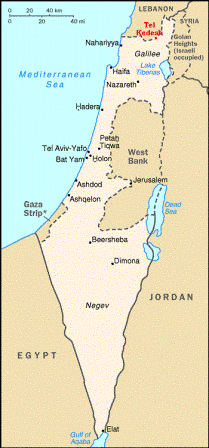 Tel Kedesh is a large tel site in Upper Galilee, occupying an area of ca. 20-25 acres. It is located on the land of Kibbutz Malkia, some 450 meters above sea level and about 10 kilometers northwest of Hazor. Situated in one of the richest agricultural zones of modern Israel, the area of Kedesh and the Upper Galilee has been home since antiquity to a tapestry of cultural and ethnic groups, from the Israelite tribe of Naphtali to Phoenicians from the nearby city of Tyre.
Tel Kedesh is a large tel site in Upper Galilee, occupying an area of ca. 20-25 acres. It is located on the land of Kibbutz Malkia, some 450 meters above sea level and about 10 kilometers northwest of Hazor. Situated in one of the richest agricultural zones of modern Israel, the area of Kedesh and the Upper Galilee has been home since antiquity to a tapestry of cultural and ethnic groups, from the Israelite tribe of Naphtali to Phoenicians from the nearby city of Tyre.
The University of Michigan/University of Minnesota Excavations at Tel Kedesh began in 1997 to investigate material evidence for Phoenician presence in the Hellenistic and Roman periods. After two exploratory and survey seasons and seven excavation seasons, the team has uncovered evidence of a monumental administrative building dating to the Persian (6th-4th centuries BCE) and Hellenistic (3rd-first half 2nd) periods. The discovery of over 2000 clay seal impressions, or bullae, in 1999 and a Ptolemaic gold coin minted in Cyprus in 2010 attest to the prominence and wealth of Kedesh in the regional landscape.
Literary and Historical Documentation
Kedesh is mentioned in the Old Testament, most importantly as one of the “cities of refuge” for those guilty of unintentional homicide. It also appears in several of the histories from the period of Graeco-Roman occupation. We learn from Zenon, a 3rd-century BCE traveler from Egypt, that Kedesh was a flourishing farming village in his time, providing him with food supplies and the luxury of a bath. From First Maccabees we hear that Kedesh was the Greek campsite for a battle between Jonathan and the Seleucid king Demetrias in 145 BCE and that its pagan occupants fled after the Jewish victory. According to Josephus, Kedesh was again a Tyrian outpost and stronghold in the first centuries BC and AD; and it served as an encampment for the Roman general Titus at the beginning of the First Jewish Revolt.
The ancient texts indicate that Kedesh passed in and out of Tyrian control from the Persian period onward and came, at least briefly, under the rule of the Hasmoneans and perhaps Herod the Great in the mid-1st century BCE. The social and economic effects of such shifts between Jewish and Phoenician control are special objects of study.
The University of Michigan/University of Minnesota Excavations
Tel Kedesh and its environs are demonstrably rich in remains from the Early Bronze Age to modern times and have clear potential to elucidate the issues outlined above as well as many other questions. A site of this size demands extensive pre-excavation exploration and testing to insure, insofar as possible, that major field seasons will yield maximum information with minimal destruction. To these ends two short exploratory seasons in 1997 and 1998 aimed to determine the location and extent of the Hellenistic and Roman remains and to prepare the site for excavation. Preliminary activities included a locational survey, two small probe trenches, a magnetometry survey on the southern tel, and contour mapping of the entire site. Results of the 1997 and 1998 work demonstrated the presence of significant and accessible Hellenistic remains on the southern tel, some portion of which most likely belonged to the Tyrians who abandoned the site after the defeat of Demetrias by the Maccabees around 145 BCE.
Major excavation seasons were undertaken in the summers of 1999 and 2000. The work concentrated at the southern end of the lower mound, where magnetometry had shown the potential for a large structure. Excavations there uncovered approximately 20% of an enormous Hellenistic building (56 meters east-west by 40 meters north-south), abandoned shortly after the middle of the 2nd century BC and built over a Persian-period predecessor. The size, internal fittings, and especially the finds of the Hellenistic building—including an archive represented by 2,043 stamped clay seal impressions—indicate that this was a public administrative center, probably housing either the governor of the eparchy of Galilee or the strategos of Coele-Syria.
The finds show compelling affinities with the material culture of Hellenistic Phoenicia with a considerable admixture of Greek elements. Some parts of the building were reoccupied shortly after its abandonment by people living in a much less grandiose manner, but whose material culture also reflects Hellenistic Phoenician influences. These findings can inform larger historical issues, including the Persian administration of the region from the 5th century BCE and relations among the Tyrians, the Seleucids, and the Jews in the first half of the 2nd century BCE. The nature and timing of the abrupt dissolution of this administrative base just after the middle of the 2nd century BCE reflect significant changes in the balance of power in the region.
Excavations persisted at Kedesh in 2006, 2008, 2009, 2010 and 2012. During these seasons we continued to concentrate our work on the Hellenistic administrative building at the south end of the tel. We uncovered about three-quarters of the building and have evidence for a Persian period predecessor (6th-4th century BCE) below it. Our most spectacular find came to light on the last day of the 2010 season, a gold coin minted by Ptolemy V in 191 BCE. This rare object demonstrates the wealth and political connections of the Hellenistic administrators.
Preparations are underway for the final excavation report of the Persian and Hellenistic Administrative Building: its phases (Persian, Hellenistic, and post-administrative ‘squatter’), architecture, pottery, bullae, administrative and domestic items.

